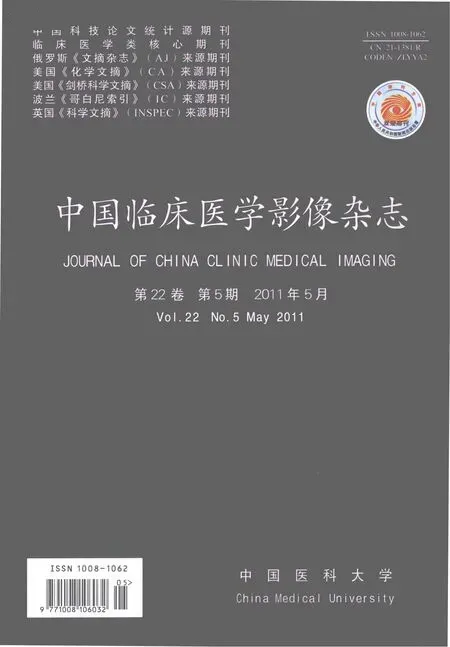MR三维快速非对称自旋回波序列对外展神经脑池段的显示
2011-02-07张莹莹徐荣天
王 琦,张莹莹,徐荣天
(1.辽宁省血栓病中西医结合医疗中心,辽宁 沈阳 110101;2.中国医科大学附属第一医院,辽宁 沈阳 110001)
外展神经因其精细复杂的解剖结构,在二维MR影像上很难被显示。外展神经起源于第四脑室底的神经核团,从脑干前方近中线处的脑桥延髓沟穿出,然后向前侧方上升沿斜坡通过桥池,越过颞骨岩尖部,至鞍背外侧,穿过硬脑膜进入Dorello氏管,最后穿过海绵窦经眶上裂进入眶内[1-2]。近年来,随着MR水成像技术的发展,三维FSE序列和三维CISS序列的应用使得正常外展神经脑池段显像成为可能。然而,与三维FASE序列相比,三维CISS序列更容易出现因成像时间长和患者不自主运动所造成的脑脊液流动和磁敏感伪影[3-9]。本研究中,在不应用对比剂的情况下,我们采用三维FASE成像序列在三分钟内获得外展神经影像。
1 材料和方法
本研究中,15名健康志愿者,男9名,女6名。年龄18~63岁,平均46岁。实验前15名志愿者均签署知情同意书。
所有志愿者采用1.5Tesla MR(Visart,Toshiba,Tokyo,Japan)进行扫描,扫描序列3D FASE的参数如下:TR:6000ms,TE:240ms,ETL:208,FOV:160mm ×160mm, 矩 阵 :384×384,层厚:1.0mm。扫描范围从延髓上部到延髓顶部,扫描基线平行于听眶线。该方法体素大小为0.42mm×0.42mm×1.0mm,扫描时间2分47秒。
在原始扫描数据中,采用连续层面追踪外展神经,即可观察从桥延沟到Dorello氏管的外展神经脑池段。在Toshiba ALATOVIEW磁共振工作站,沿外展神经的特殊走行方向,采用MPR技术对原始影像资料进行图像重建。其中斜冠状位重建平面可以显示双侧外展神经脑池段全程;而斜矢状位重建平面可以显示与轴位平面垂直的单侧外展神经脑池段。在斜冠状位重建图像上,观测外展神经脑池段中心部分的直径。
2 结果
用外展神经管作为标志,80%的病例在矢状位和冠状位重建图像上外展神经被识别和显示(图1,2)。其中2例双侧外展神经没有显示,2例单侧外展神经未被显示。在三维快速成像序列图像上外展神经脑池部直径范围在1.18~1.55mm,平均直径为1.35mm(表1)。

图1 斜冠状位重建图像可以显示双侧外展神经脑池段 (箭头)和Dorello氏管(箭)的冠状解剖结构。图2 斜矢状位重建图像可以显示与轴位平面垂直的单侧外展神经脑池段(箭头)和Dorello氏管(箭)的矢状解剖结构。Figure 1.Oblique coronal reconstructed image.The oblique coronal reconstructed image could display the coronal view of the cisternal segment of the bilateral abducent nerve(arrowheads)and Dorello’s canal(arrows).Figure 2.Oblique sagittal reconstructed image.The oblique sagittal reconstructed image could display the sagittal view of the cisternal segment of the unilateral abducent nerve(arrowheads)and Dorello’s canal(arrow)in the direction vertical to the axial plane.

表1 三维FASE序列对外展神经脑池段的显示
3 讨论
用于评估外展神经脑池段和内耳结构的MR序列的标准:高信噪比、高的脑脊液与神经或骨骼组织对比、高空间分辨率、能任意方向重建,扫描时间短[7]。本研究应用3D FASE序列,它是采用半傅立叶转换单次激发(一个长回波链)快速自旋回波序列扫描,利用K空间数据的相位对称性,在不降低图像空间分辨率的同时,相应缩短扫描时间,以致可以在短时间内就能够获得较高分辨的容积数据。3D FASE序列采用较长 TR(6000ms)、较长 TE(240ms)进行扫描,以形成重 T2加权图像,这样脑池内除脑脊液外其它任何解剖结构均显示为低信号,然后按照外展神经的特殊走形方向用MPR技术进行图像重建[7,10]。这样在脑池成像图像中,可以在高信号的脑脊液背景中识别低信号的外展神经脑池段的解剖形态(图1,2)。
我们在连续层面追踪外展神经,依照它的解剖形态、起止点及走形方向识别它,最终以Dorello氏管作为确认标志。Dorello氏管位于颞骨岩部尖端,由蛛网膜或硬脑膜形成的鞘包被外展神经进入Dorello氏管,因此在Dorello氏管内可见由脑脊液围绕的外展神经,这种特殊解剖结构使得Dorello氏管在 3D FASE 序列图像成为外展神经的确认标志(图 1,2)[3-4,11]。本研究中,用Dorello氏管作为标志,能够识别80%的外展神经(24/30),而运用三维CISS序列和三维FSE序列分别选择层厚1.0mm和0.8mm[4-5],同样80%的病例可显示出外展神经,但是选择层厚0.66mm时[3],因空间分辨率不同,三维CISS序列成像显示率较高。在三维FASE序列图像上,外展神经脑池段的平均直径是1.35mm,小于解剖直径(2.2mm)[12],分析可能是因为部分容积效应模糊了外展神经的边界[13],以及扫描平面和外展神经间角度的影响。六根未能确认的外展神经是因为:①两例志愿者的双侧Dorello氏管不能确认;②在另2例志愿者的连续层面不能追踪到单侧外展神经脑池段的全程。据报道,在某些病例中,外展神经表现为两干(28.57%~40%)或三干(10.71%),各神经干进入Dorello氏管时通常通过一个硬膜孔,偶尔通过两个硬膜孔[2,11-12,14-15],因此由于这种多干的神经太细,并且所通过的硬膜孔太狭小,所以不能容纳脑脊液,使得Dorello氏管在三维FASE序列图像上不能显影。
为了显示外展神经脑池段的全程,我们采用两种特殊的平面重建图像,即斜矢状位、斜冠状位重建分别显示外展神经脑池段的解剖形态和Dorello氏管的结构。该方法可用于评估外展神经与周围组织结构的解剖关系。
[1]Williams PL,Bannister LH,Berry MM,et al.Gray’s anatomy[M]//Berry MM,Standring SM,Bannister LH.Nervous System.New York:Churchill Livingstone,1995.1240-1243.
[2]Umansky F,Valarezo A,Elidan J.The microsurgical anatomy of the abducens nerve in its intracranial course[J].Laryngoscope,1992,102:1285-1292.
[3]Yousry I,Camelio S,Wiesmann M,et al.Detailed magnetic resonance imaging anatomy of the cisternal segment of the abducent nerve:Dorello’s canal and neurovascular relationships and landmarks[J].J Neurosurg,1999,91:276-283.
[4]Lemmerling M,De Praeter G,Mortele K,et al.Imaging of the normal pontine cisternal segment of the abducens nerve,using three-dimensional constructive interference in the steady state MRI[J].Neuroradiology,1999,41:384-386.
[5]Bobek-Billewicz B,Dziewiatkowski J.The value of the heavily T2-weighted sequence in evaluation of the cisternal and petroclival segment of the abducent nerve[J].Folia Morphol(Warsz),2001,60:69-72.
[6]Naganawa S,Koshikawa T,Fukatsu H,et al.MR cisternography of the cerebellopontine angle:comparison of three-dimensional fast asymmetrical spin-echo and three-dimensional constructive interference in the steady-state sequences[J].AJNR,2001,22:1179-1185.
[7]Yang D,Kodama T,Tamura S,et al.Evaluation of the inner ear by 3D fast asymmetric spin echo(fast)MR imaging:phantom and volunteer studies[J].Magn Reson Imaging,1999,17:171-182.
[8]Ono K,Arai H,Endo T.Detailed MR Imaging Anatomy of the Abducent Nerve:Evagination of CSF into Dorello Canal[J].AJNR,2004,25:623-626.
[9]梁长虎,柳澄,武乐斌,等.3D-CISS序列在脑池段动眼神经及其神经血管关系显示中的应用[J].实用放射学杂志,2006,22:1297-1300.
[10]Yamakawa K,Naganawa S,Maruyama K,et al.Clinical evaluation of three-dimensional MR-cholangiopancreatography using three-dimensional Fourier transform fast asymmetric spin echo method(3DFT-FASE):usefulness of observation by multi-planar reconstruction[J].Radiat Med,1999,17:15-19.
[11]Destrieux C,Velut S,Kakou MK,et al.A new concept in Dorello’s canal microanatomy:the petroclival venous confluence[J].J Neurosurg,1997,87:67-72.
[12]Marinkovic SV,Gibo H,Stimec B.The neurovascular relationships and the blood supply of the abducent nerve:surgical anatomy of its cisternal segment[J].Neurosurgery,1994,34:1017-1026.
[13]Du YP,Parker DL,Davis WL,et al.Reduction of partial-volume artifacts with zero-filled interpolation in three-dimensional MR angiography[J].J Magn Reson Imaging,1994,4:733-741.
[14]Jain KK.Aberrant roots of the abducent nerve[J].J Neurosurg,1964,21:349-351.
[15]Nathan H,Ouaknine G,Kosary IZ.The abducens nerve:anatomical variations in its course[J].J Neurosurg,1974,41:561-566.
